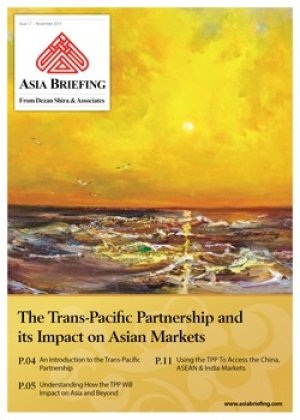Cascade Asia Upbeat on Renewed Opportunities in Indonesian Manufacturing
As businesses look away from China and towards other countries to fulfill their manufacturing needs, Indonesia is an increasingly attractive prospect. With a massive workforce, a growing middle class, and newly established investment incentives, Indonesian leaders are making clear their commitment to promoting Indonesia as a hub of manufacturing in Southeast Asia.
Although Indonesia shows promising signs of growth in the manufacturing industry, regulations governing the sector are still cumbersome and are further complicated by governmental red tape. Ambiguous legislation, combined with stark regional differences in infrastructure, make it imperative for prospective investors to understand the Indonesian manufacturing climate. In this respect, Manufacturing in Indonesia: new options, opportunities and challenges, published by Cascade Asia Advisors, provides a clear overview of the current investment environment and considers the investment incentives, the fastest growing sectors, and the most cost effective locations in the country.
The following is a brief outline of Cascade Asia’s insightful article, which highlights the momentum that will move Indonesia closer to its goal of rebuilding its manufacturing industry.
Indonesia’s Manufacturing History
Before the Asian Financial Crisis in 1997, Indonesia’s manufacturing industry was strong and growing. Just two years before the crisis, Indonesia reported over 12 percent growth in its non-oil and gas sectors. However, this growth dropped to just above 4 percent by 2001. Following the crash, the manufacturing industry has struggled to maintain steady growth, experiencing sharp falls and rises between 2004 and 2011. Yet, despite the volatility, average annual growth in the sector registered at 5.5 percent over the same period. In 2014, President Joko Widodo who is also known as Jokowi, took office with a decisive commitment to the stabilization and reformation of the manufacturing sector.
Jokowi’s Plan of Action
Jokowi considers manufacturing a key sector for bolstering the Indonesian economy and creating jobs for 2.3 million new entrants to the workforce annually. The Indonesian government has made concrete steps towards attracting FDI to the manufacturing industry in recent years. Since taking office, Jowoki has released a new negatives list, which allows foreign investors access more industries, including raw pharmaceuticals. In addition to the liberalization of investment, reforms have created a one stop shop for investment approvals, introduced export incentives, created special economic zones, and offered import benefits all to promote manufacturing investment. In the wake of these changes, officials project manufacturing’s contribution to national GDP to increase by 8.5 percent, reaching 30 percent by 2025. Jokowi has also mentioned the possibility of joining the Trans-Pacific Partnership. Although this is a tentative and distant proposal, it could increase exports by an estimated US$ 2.9 billion. The government must also attempt to quell investors’ concerns of the subpar national productivity level.
Manufacturing Sector Demographics
Abundant natural resources and a growing middle class of consumers continue to make Indonesia an attractive manufacturing destination. These same factors also support a large food and beverage manufacturing sub-sector. However, few existing food and beverage enterprises have an international focus, which presents a major opportunity for new investors. Electronics, automotive, and chemicals/pharmaceuticals represent the strongest manufacturing sub-sectors in Indonesia, after food and beverage manufacturing. Non-technological sectors showed growth from 2012-2015, while automotive and electronics sectors registered high levels of growth in the first quarter of 2016. On the whole, the government is pushing to increase the presence of ten specific higher value added industries, including capital goods, energy, and textiles.
Manufacturing Centers
Jakarta, Bandung, and Surabaya represent the major locations of manufacturing in Indonesia, and they are all on the island of Java. These locations are popular because of their infrastructure, but the government is making a push to build up the infrastructure in periphery areas where wages are 40-50 percent lower. Within 15 years, the government aims to create 36 additional manufacturing hubs outside of Java to attract new investors. Cumulatively, Indonesian manufacturing costs are roughly one third of those in China, but Jokowi and his administration need to provide the mechanisms for investors to take advantage of Indonesia’s offerings outside of Java.
|
Cascade Asia Advisors is a boutique intelligence and strategic advisory firm focused on Southeast Asia. Combining premium analytics with proprietary market insight, Cascade Asia’s seasoned experts are perfectly positioned to recognize market opportunities, manage political and regulatory risk and systematically assess the transnational, macroeconomic and political drivers of financial markets across the pacific. For information about developments mentioned in this report, please contact them at info@cascadeasia.com. |
Annual Audit and Compliance in ASEAN
For the first issue of our ASEAN Briefing Magazine, we look at the different audit and compliance regulations of five of the main economies in ASEAN. We firstly focus on the accounting standards, filing processes, and requirements for Indonesia, Malaysia, Thailand and the Philippines. We then provide similar information on Singapore, and offer a closer examination of the city-state’s generous audit exemptions for small-and-medium sized enterprises.
 The Trans-Pacific Partnership and its Impact on Asian Markets
The Trans-Pacific Partnership and its Impact on Asian Markets
The United States backed Trans-Pacific Partnership Agreement (TPP) includes six Asian economies – Australia, Brunei, Japan, Malaysia, Singapore and Vietnam, while Indonesia has expressed a keen willingness to join. However, the agreement’s potential impact will affect many others, not least of all China. In this issue of Asia Briefing magazine, we examine where the TPP agreement stands right now, look at the potential impact of the participating nations, as well as examine how it will affect Asian economies that have not been included.
 An Introduction to Tax Treaties Throughout Asia
An Introduction to Tax Treaties Throughout Asia
In this issue of Asia Briefing Magazine, we take a look at the various types of trade and tax treaties that exist between Asian nations. These include bilateral investment treaties, double tax treaties and free trade agreements – all of which directly affect businesses operating in Asia.

 About Cascade Asia
About Cascade Asia 







